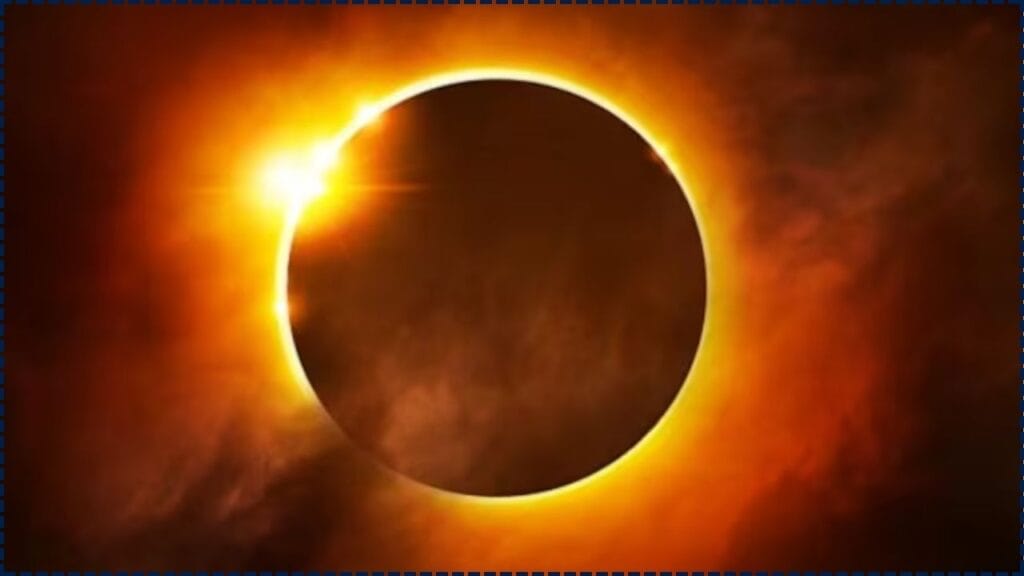NASA Shares Rare View of the Sun Eclipsed by the Moon: NASA recently shared an awe-inspiring photo of the Sun partially eclipsed by the Moon, as seen from space. The image was captured by NASA’s Solar Dynamics Observatory (SDO) and gives us a view of the universe that’s literally out of this world — something you won’t catch by just looking up from your backyard.

Unlike a typical eclipse seen from Earth, this one was visible only from the SDO’s unique position in space, offering an angle that’s impossible to see from the ground. The snapshot shows the Moon blocking about 23% of the Sun’s fiery surface, casting a shadow that’s breathtaking in its simplicity and cosmic scale.
NASA Shares Rare View of the Sun Eclipsed by the Moon
NASA’s rare image of a partial solar eclipse from space is more than just a cool picture — it’s a symbol of how far our tech has come and a reminder of how much we still have to learn. While we may not all be astronauts, these glimpses into space help us better understand the Sun that powers our world.
Whether you’re a stargazer, a scientist, or just someone who loves a good space photo, one thing is clear: the universe still knows how to show off.
What Makes This Eclipse So Special?
We’ve all seen photos of eclipses from Earth, but space adds an entirely different vibe. This time, the Moon passed directly between the Sun and the SDO spacecraft, blocking part of the Sun’s surface and creating a cosmic photo op that NASA couldn’t miss.
No Atmosphere, No Problem
From Earth, eclipses are filtered through our atmosphere, which can blur or distort the view. But in space, the lack of atmosphere means crystal-clear images — perfect for studying solar activity.
Why It Matters
This isn’t just for pretty pictures. These space-based eclipse views let scientists:
- Monitor the Sun’s outer atmosphere (called the corona)
- Study solar flares and sunspots
- Understand space weather, which can mess with our satellites and GPS systems
“Solar eclipses from space offer us an invaluable opportunity to observe the corona without Earth’s atmospheric interference,” said Dr. C. Alex Young, Associate Director for Science at NASA’s Heliophysics Division.
How NASA Captured the Moment
NASA’s Solar Dynamics Observatory, launched in 2010, is one of the space agency’s frontline solar research tools. It circles Earth in a geosynchronous orbit, keeping a steady eye on the Sun 24/7.
Instruments on Board
- Atmospheric Imaging Assembly (AIA): Captures ultra-high-res images in 10 wavelengths.
- Helioseismic and Magnetic Imager (HMI): Maps magnetic fields and solar oscillations.
- Extreme Ultraviolet Variability Experiment (EVE): Measures solar radiation.
When the Moon slipped into the SDO’s line of sight, the AIA snapped the shot — creating one of the clearest partial eclipse images ever seen.
Space Weather: Why We Should Care
When we talk about solar eclipses and solar flares, it’s not just a science geek thing. These events can cause real-world problems, like:
- Power grid disruptions
- Radio blackouts
- Delays in airline navigation
That’s why monitoring the Sun’s behavior is more than a hobby — it’s crucial to national infrastructure and public safety.
Real Talk: Solar Storms and You
Solar storms can:
- Knock out satellites
- Fry your GPS
- Affect astronauts in orbit
NASA and NOAA (National Oceanic and Atmospheric Administration) use SDO data to predict solar storms before they hit Earth.
Lessons from the International Space Station (ISS)
During the April 8, 2024 total solar eclipse, astronauts aboard the International Space Station (ISS) recorded the Moon’s shadow as it moved across the Earth at nearly 5,000 miles per hour. That event was also captured on video and showcased the wild contrast between day and night from 250 miles above our planet.
NASA Shares Rare View of the Sun Eclipsed by the Moon See an Eclipse (Like NASA Would)
Can you experience anything close to NASA’s space view from Earth? Not quite, but here are some tips to get the best view of a solar eclipse safely:
1. Get Certified Eclipse Glasses
Regular sunglasses? Nope. You need ISO 12312-2 certified glasses.
2. Use a Solar Filter on Your Camera
Want to snap a shot like NASA? You’ll need a proper solar filter lens.
3. Find the Path of Totality
During a total eclipse, the best view is inside the path of totality. Use NASA’s eclipse map to find where and when it will be visible near you.
FAQs
Q: Can people on Earth see eclipses like this?
A: No, this one was only visible from the SDO’s location in space.
Q: What’s the difference between a solar eclipse from Earth and one from space?
A: From Earth, you see the eclipse through the atmosphere. In space, you get a clear, uninterrupted view — no clouds, no distortion.
Q: Are there more space-based eclipse missions coming?
A: Yes! NASA plans more solar observatories, including the PUNCH mission (Polarimeter to Unify the Corona and Heliosphere), launching soon.
Q: Do space eclipses help science?
A: Absolutely. They help us understand the corona, solar winds, and how the Sun’s activity affects Earth.












